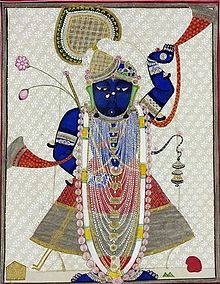Nathdwara Painting refers to a painting tradition and school of art that emerged in Nathdwara, a city in Rajsamand district in the Western state of Rajasthan in India. Inspired by the Thanjavur Painting, Nathdwara paintings are of different sub-styles of which Pichhwai paintings are the most popular.[1] The word Pichwai derives from the Sanskrit words pich meaning back and wais meaning hanging. These paintings are cloth paintings hung behind the image of the Hindu god Shrinathji.[citation needed]



Origin and area
editThe Nathdwara school is a subset of the Mewar school of painting and is seen as an important school in the 17th and 18th century miniature paintings. The sub-styles of Mewar painting include Udaigarh, Devgarh and Nathdwara as important centers of miniature painting art. The temple of Shrinathji is believed to have provided a boost to the art activities in the town. It is recorded that to avoid the oppression of the iconoclast Mughal emperor Aurangzeb, the image of Shrinathji, a child manifestation of Krishna was installed in Nathdwara in 1670 by Goswami priests from Mathura. After this, many artists, including the famous Acharya Gopinathji, motivated by religious fervor came and created paintings of Srinathji.[2]
Pichhwai are intricate paintings which portray various aspects of Lord Krishna's life. This art has become an undivided part of the Nathdwara culture.
The purpose of Pichhwais, other than its artistic appeal, is to narrate tales of Krishna visually. Pichhwai painting is in a great demand around the globe.
These artists mostly live in Chitron ki gali (Street of paintings) and Chitrakaron ka mohallah (colony of painters) and make a close community with constant interaction. It is no wonder that many times a Pichhwai painting is a group effort, where several skillful painters work together under the supervision of a master artist.
Themes
editMost works produced in this style revolve around the figure of Shrinathji as a manifestation of Krishna and refer to the incident of him holding the Govardhan hill on his last finger. Each pichwai painting is considered a seva or an offering to the deity and hence personifies Shrinathji as a prince with jewels and luxuries, surrounded by the milkmaids, gopis. These seva themes are based on different seasons and paintings are made to depict different moods of the season.[3] There are also paintings that show the Lord in different costumes celebrating different festivals. Other themes like Mata Yashoda, Nandlal and Balgopal figures are also painted in this style.[4] Some of the paintings are gem-encrusted.[5]
See also
editReferences
edit- ^ "Temple of Doodh". Economic Times. 15 August 2002. Archived from the original on 3 January 2013. Retrieved 14 January 2012.
- ^ "Celebrating Nathdwara paintings". The Times of India. 30 November 2008. Archived from the original on 23 October 2012. Retrieved 14 January 2012.
- ^ Kapur, Mita (21 August 2005). "Work is worship". The Hindu. Archived from the original on 11 October 2013. Retrieved 9 March 2012.
- ^ Neeraj, Jai Singh; Nīraja, Jayasiṃha (1991). Splendour of Rajasthani Painting. Abhinav Publications. ISBN 9788170172673.
- ^ "Weaving art with charity". Hindustan Times. 20 August 2010. Retrieved 2 April 2012.